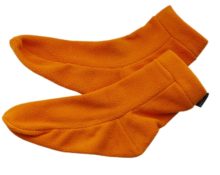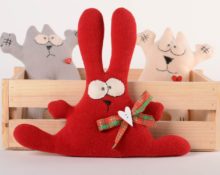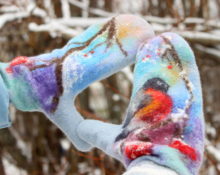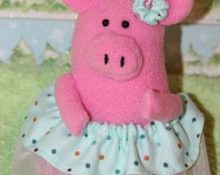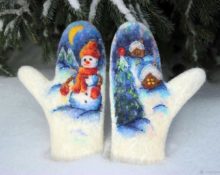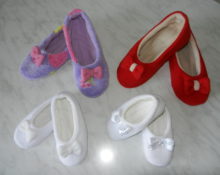In the cold season, mittens are one of the main attributes of women, children and adults. They help protect the skin from cold air and snow and provide warmth and comfort to the palms. Wool or yarn are not always suitable materials as they can cause an allergic reaction. The best option would be to use fleece fabric. You can sew fleece mittens yourself.
Options for insulating mittens
The presence of a lining will help provide additional warmth for the handles. Several textures may be useful for placement on the reverse side.
Velboa fur is most often used as insulation material. It is a fabric with soft pile. Acrylic is used in production. Velboa has a dense and wear-resistant structure, as well as an attractive appearance. The surface is fleecy, soft and pleasant to the touch, which will give not only warmth, but also a feeling of comfort.
Acrylic has a wide range of applications. Both the material itself and its derivatives can be used as insulation. It is characterized by high wear resistance, is not subject to deformation, and retains heat for a long time. One of the main positive qualities is the hypoallergenic nature of the product. Using mittens lined with acrylic will not cause serious harm to health.
Many needlewomen also use artificial or natural fur. This material will not only provide additional warmth, but will also give special softness when walking. A thin knitted fabric with a durable and wear-resistant structure will also come in handy.
Patterns of fleece mittens for adults and children
An important step when sewing warm products yourself is preparing the pattern. Patterns for adults and children are prepared according to special recommendations.
Note: You can use a ready-made product as a basis.
Materials:
- cardboard or paper;
- pencil;
- scissors;
- textile.
In order to prepare to sew fleece mittens for a small child, you will need a special template. To create it, you need to place your palm on a sheet of cardboard or paper and carefully circle it.
When drawing, you should make the pattern freer in the area of the fingers. To do this, you can add about 1.5 centimeters to the original contour. When shaping the girth of the wrist area, you can slightly lengthen the contour. The extra centimeters will help you sew an elastic band into the product, which will provide additional fastening on the arm. Parts for each hand are made in duplicate.
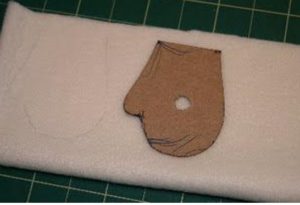
When creating a pattern for mittens for adults, you need to put in a little more effort. The mitten consists of two elements - a front and a back piece.The front half has a solid side, from the fingers to the wrist. As a template, you can trace the outline of your palm, stepping back about two centimeters. The thumb must be bent.
The back half can be made based on the already finished front part. The upper part should be carefully folded to the base of the thumb. Carefully trace the outline of the bottom half onto the cardboard, taking in the thumb area.

Reference: building the back half of the pattern on the base of the front piece will help to accurately lay out the outline so that the finished pieces match each other's measurements.
Master class on how to sew a fleece mitten for a child with your own hands
Mittens for a small child are the best option in cold weather, since gloves are not always convenient to put on and use. Fleece fabric will protect the skin of your hands from aggressive environmental influences and keep you warm when walking.
Before starting the process, you should prepare the necessary tools for the job.
Materials:
- paper patterns 4 copies;
- safety pins;
- marker or pencil;
- scissors;
- sewing machine;
- additional accessories (optional).
Patterns prepared on paper are transferred to fabric. To draw the outline, you can use a special marker or a simple pencil.
Attention: Traces left by the marker will disappear after the first wash, which will preserve the aesthetic appearance of the product.
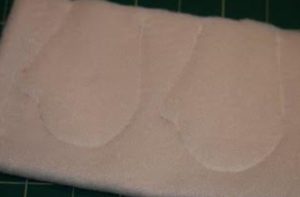
The template is carefully cut out using scissors. On the wrong side, it is recommended to mark the final location of the seam. After marking, both components of one mitten are pinned together with safety pins. Then you can start working on the sewing machine. For sewing, a regular stitch with a minimum pitch is suitable. Pins should be removed as stitching progresses.
The front side can be further decorated. Thermal stickers that are transferred to the surface using an iron are suitable for this. But rhinestones, stripes with bright patterns or favorite fairy-tale characters will also come in handy. Faux fur is suitable for decorating the cuffs. It is recommended to make it removable, which will greatly facilitate the washing process. To do this, small buttons are sewn on the wrists and loops for fastening on the fur.
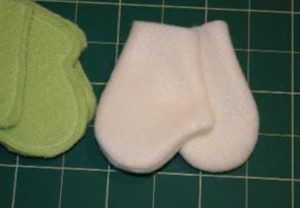
Addition: Additional decoration of mittens is recommended before processing on a sewing machine.
Children's products can be additionally equipped with an elastic band in the wrist area. It will provide a secure fit on the palm. To do this, the elastic is located at a distance of about two centimeters from the edge. The material is neatly folded. The stitching should be sewn carefully, making sure that the threads do not get on the elastic. It must not be applied completely.
When moving to the second half of the product, the edge is carefully folded, the parts are placed next to each other, and the stitching continues. The parts are folded with the wrong side out. The fabric needs to be slightly gathered and the elastic slightly loosened. After obtaining the required elasticity of the elastic, the seam can be completed. The excess is cut off and the edges of the elastic are sewn by hand. Once the materials are finished, the remainder of the material is hemmed by machine.
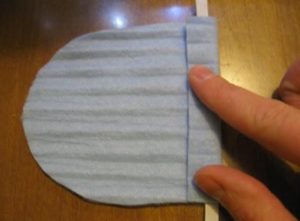

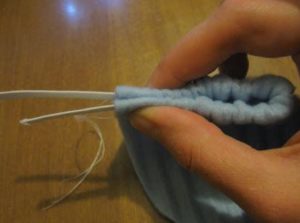
How to make a fleece mitten lining
The presence of a lining will provide additional protection for the skin. When cutting, previously prepared patterns will be useful. Using a marker or pencil, the patterns are transferred to the fabric chosen as the lining. After preparation, the templates are carefully cut out.
Important: When designing the lining, you need to leave about half a centimeter, which is spent on the hem for the seam.
Templates for the linings are made in four copies - two for each mitten. The parts are neatly folded with the product. For additional fixation, you can use tailor's pins. A blanket stitch is suitable for stitching. First of all, it is recommended to hem the thumb area around the entire perimeter. Then sew the entire lining around the perimeter, from cuff to cuff. Finally, the wrist area is treated. The lined mittens are ready to use.
Conclusion
Fleece fabric is used to sew most warm wardrobe items. Mittens that protect your palms in frosty weather are no exception. Using a few tricks, you can sew fleece mittens yourself. Such products are suitable for cold weather, will be particularly original and will fully meet the personal requirements of their owner.


 0
0